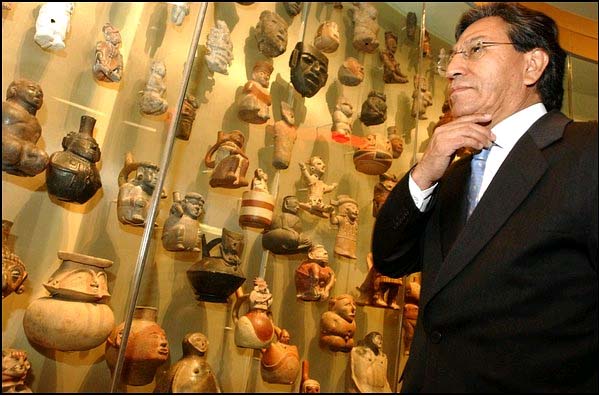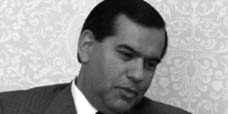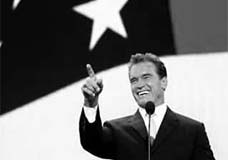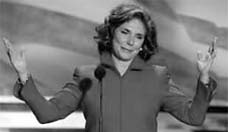
Alejandro Toledo wandered the galleries of the National Museum of the American Indian on Friday, one more visitor among the men, women and children, some in native American dress. He mused about his feelings for the place, which went beyond the exhibits and the building.
'A Movement That Is Going to Be Very Difficult to Stop'
At Indian Museum, Peruvian Leader Cites Growing Indigenous Influence
By Peter Eisner
Washington Post Foreign Service
Sunday, September 26, 2004; Page A22
Caption: President Alejandro Toledo of Peru views some pre-Columbian art at the National Museum of the American Indian. (Jonathan Ernst For The Washington Post)
Alejandro Toledo wandered the galleries of the National Museum of the American Indian on Friday, one more visitor among the men, women and children, some in native American dress. He mused about his feelings for the place, which went beyond the exhibits and the building.
"I have a hunch that we are witnessing a movement that is going to be very difficult to stop," he said. "What we are asking for is to be included into the life of this country or the Americas . . . we the people who were originally here."
Toledo is a Quechua Indian. He is also the president of Peru. "I am the first indigenous Peruvian who was democratically elected in 500 years," he said. "That implies an enormous expectation and a heavy weight on one's shoulders. I'm sentenced not to fail."
Toledo, who had come to Washington earlier in the week to speak at the museum's opening ceremonies, described the building as "a profound symbol of reconciliation." On Friday he returned for a personal pilgrimage, changing his schedule and delaying his trip home.
Toledo was born poor in Peru, worked as a shoeshine boy, and parlayed a high school scholarship into entrance to the University of San Francisco and eventually a PhD at Stanford. If his life is a unique example of bridging cultural and social divides, he said, his mission is to bring more profound change to his country, and to Latin America.
"My case is an accident," he said. "But I'm going to take advantage of this accident, to provide people with the ability to be heard, to invest in social and economic programs."
Toledo said he wanted to persuade the world's wealthiest nations to invest in the poorest countries in the world, particularly those in Latin America. "Not to hand us more money," he said, but "to invest more in health, education, rural electrification; we need more financial breathing room." He did not mention the United States by name. But the implication was clear as he looked out from the museum toward the U.S. Capitol.
Directors of the museum said Toledo's return to the museum was a poignant gesture. He and the museum staff members talked about the period of Europeans' arrival in the Western Hemisphere, when their encounters with indigenous cultures defined what would become known as the New World.
"This is the greatest story ever told, the idea of the meeting of the two halves that made a new world when they met," said Bruce Bernstein, the museum's assistant director for cultural resources. "It's all of our stories . . . and we can then look at the ways that our lives and our cultures are interwoven."
Toledo, 58, walked hand in hand with his wife, Eliane Karp, stopping at exhibits of the Inca civilization of the Andes, which had as its capital the Peruvian city of Cuzco. Karp, an anthropologist, met Toledo at Stanford. Belgian-born, she has become a specialist in Latin American indigenous cultures and speaks the Quechua language.
"Eighty percent of the people in Peru are of Indian origin," said Karp. The Quechua "have very high aspirations of being connected, being involved in politics. . . . They have the aspirations of the poor . . . of getting out of poverty."
Toledo and Karp stopped at one display that had special meaning: gold medallions, masks and other artifacts surrounding an ingot of gold, taken in the 16th century by Spanish conquerors, prominent among them Hernan Cortez, who defeated the Aztecs in Mexico.
"The middle bar here is actually what Cortez did with the wealth, with the silver and gold . . . he melted it down and sent it to Europe," Bernstein said.
Toledo was pensive. "Beyond the gold that was used to pay the debt of some European countries, perhaps what we lost was a great part of our own culture," he said.
Elected in 2001 after a series of corruption and human rights scandals drove President Alberto Fujimori from power, Toledo has seen his approval ratings in public opinion polls plummet to single digits. He said he was weighed down by expectations. He is among a group of presidents in the Andean region who face protests demanding jobs and an end to corruption. More than half of Peru's 28 million people live in poverty.
"I am an economist, but I am not a miracle maker," he said. Yet he said he understood the demands of Peru's Indians. "Listen Toledo, you have been a hero, to lead us into freedom and democracy," he recalled people telling him. But now, he said, people say, "I need a raise, I need a job."
Indigenous movements are now playing a larger role in the politics of Andean nations. Protests by Indian groups last year ousted the president of Bolivia and earlier this year challenged the tenure of the president of Ecuador. Both countries share borders with Peru, where more than half the population identifies itself as Indian.
"These movements in their own right demand to be included, to be part of the economic and political life of their own nations," Toledo said. "I understand the frustrations."
Indians in Peru, he said, "being the majority, they were excluded, and we are still excluded. Five percent of the population ruled the country. But it is changing."



